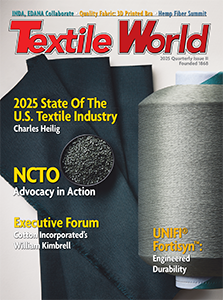Cotton Incorporated, Cary, N.C., has published “Life Cycle Assessment of Cotton Fiber and Fabric,”
a report that includes a life cycle inventory (LCI) and life cycle assessment (LCA) of cotton
products with the goal of setting benchmarks of potential environmental impacts throughout the
global cotton supply chain. The report is part of the Memphis, Tenn.-based Cotton Foundation’s
Vision 21 Project, managed by Cotton Incorporated; the National Cotton Council, Memphis; and Cotton
Council International, Washington. The comprehensive two-year study — managed by PE International,
a global strategic consultancy that provides expertise, software solutions and other services
related to sustainability performance — involved collection of data and quantification of material
and energy inputs related to fiber production and fabric manufacturing, and establishment of a
model of the environmental impact of a knit golf shirt and woven cotton trousers from fiber through
disposal.
Data from China, India and the United States — the top three cotton-producing countries —
were averaged to determine the LCI for the cradle-to-gate fiber production phase. Data from mills
in Turkey, India, China and Latin America — the top four textile-processing regions — were averaged
to determine the gate-to-gate fabric production LCI. Secondary sources added to the data used in
calculating the cut-and-sew and consumer-use LCI.
The LCA involves the environmental impact of cotton without regard to other fibers. “The
cotton LCA is about measurement, not marketing,” said Berrye Worsham, president and CEO, Cotton
Incorporated. “The textile industry and consumers alike are weary of competition-motivated green
marketing. This project is about facts, and establishing a baseline to measure cotton’s
environmental gains moving forward.”
“Vision of U.S. Cotton’s 21st Century,” or Vision 21, includes four initiatives: First, it
analyses demographics and structure in Asian markets for consumer apparel and textile products, and
also looks at underlying sources of change. Second, it establishes a program titled “Cotton’s
Revolutions” to provide a forum within the world cotton textile industry to discuss influences on
the textile and apparel sector through 2025. Third, it looks at sustainability and the
environmental aspects of the U.S. cotton chain from production through consumer handling. Finally,
it provides a study of U.S. raw cotton flow with a logistical analysis from bale formation through
delivery to the spinning mill.
September/October 2011




